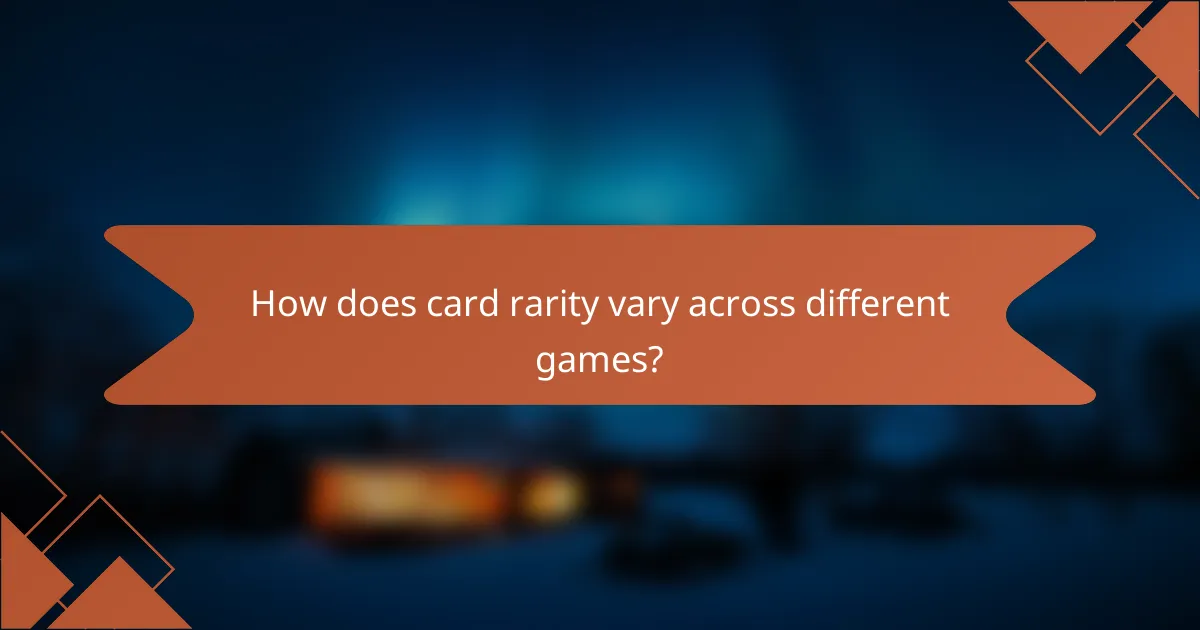Card rarity plays a crucial role in shaping gameplay and strategy by influencing the availability and potency of cards within a game. Higher rarity cards typically offer unique abilities or enhanced stats, which can significantly impact deck composition and overall tactics. By understanding the different categories of card rarity, players can make informed decisions that enhance their gameplay experience.

How does card rarity affect gameplay strategies?
Card rarity significantly influences gameplay strategies by determining the availability and power level of cards within a game. Higher rarity cards often provide unique abilities or stronger stats, which can shape deck composition and overall strategy.
Influence on deck building
Rarity impacts deck building by limiting the number of high-quality cards available to players. Players must balance their decks with a mix of common, uncommon, and rare cards, often leading to creative strategies that maximize the strengths of lower-rarity cards.
When constructing a deck, consider the synergy between cards of different rarities. A well-rounded deck may include a few rare cards complemented by a solid foundation of commons and uncommons to ensure consistency and reliability.
Impact on competitive play
In competitive settings, card rarity can create disparities among players, as those with access to rare cards may have a tactical advantage. This often leads to a meta where certain high-rarity cards dominate, influencing the strategies that players adopt.
To remain competitive, players should stay informed about the current meta and adjust their strategies accordingly, potentially including tech cards that counter popular high-rarity options.
Role in resource management
Card rarity plays a crucial role in resource management, as players must allocate their resources wisely to acquire and utilize rare cards effectively. This includes managing in-game currency or trade resources to obtain the desired cards.
Players should prioritize investing in cards that offer the best return on investment in terms of gameplay impact. Balancing rare card acquisition with the need for a stable deck can prevent resource depletion.
Effect on player decisions
The presence of rare cards can significantly affect player decisions during gameplay. Players may choose to play more conservatively to protect their valuable cards or take risks to leverage their powerful abilities.
Understanding when to deploy high-rarity cards can be pivotal. Players should assess the game state and their opponent’s resources to make informed decisions about when to play their strongest cards for maximum impact.
Examples from Magic: The Gathering
In Magic: The Gathering, rare cards like “Black Lotus” or “Ancestral Recall” exemplify how rarity can dictate gameplay strategies. These cards offer powerful effects that can turn the tide of a game, making them highly sought after.
Players often build decks around these rare cards, creating strategies that exploit their unique abilities while incorporating a mix of commons and uncommons to maintain balance and consistency in gameplay.

What are the different types of card rarity?
Card rarity is categorized into several types, each influencing gameplay and strategy differently. Understanding these types helps players make informed decisions about deck building and card value.
Common, Uncommon, Rare, Mythic Rare
Card rarity typically falls into four main categories: Common, Uncommon, Rare, and Mythic Rare. Common cards are the most frequently found and are often foundational to many decks, while Uncommon cards provide slightly more powerful effects or unique abilities. Rare cards are less available and usually offer significant advantages or synergies, whereas Mythic Rare cards are the rarest and often game-changing, featuring powerful abilities or unique mechanics.
When building a deck, consider the balance of these rarities. A deck with a mix of Common and Uncommon cards can provide stability, while including a few Rare or Mythic Rare cards can enhance your strategy. However, relying too heavily on high-rarity cards can lead to inconsistencies in drawing them during gameplay.
Special editions and promotional cards
Special editions and promotional cards are unique offerings that can vary significantly in rarity and gameplay impact. These cards may feature alternate artwork, unique abilities, or limited-time availability, making them highly sought after by collectors and players alike. They often come from events, collaborations, or specific promotions.
Incorporating special edition cards into your deck can provide strategic advantages, but be cautious of their availability and potential cost. Some may be priced significantly higher than standard cards, especially if they are part of a limited release. Always evaluate whether the benefits they provide justify the investment compared to more commonly available options.

How can players leverage card rarity in digital games?
Players can leverage card rarity in digital games by understanding how different rarity levels affect gameplay and strategy. Rare cards often provide unique abilities or advantages, making them valuable in both competitive and casual play.
Strategies for trading
When trading cards, focus on the rarity and demand of each card. Rare cards typically hold higher value, so prioritize trading them for cards that enhance your deck’s synergy or strategy. Use online marketplaces or community forums to gauge current market trends and make informed trades.
Consider creating a trading checklist that includes the rarity, demand, and potential synergies of your cards. This will help you identify which cards are worth trading and which should be kept for your collection.
Maximizing value in card collections
To maximize the value of your card collection, regularly assess the rarity and condition of your cards. Rare cards in mint condition can significantly increase in value over time, especially if they are part of a popular game or expansion. Keep track of market fluctuations to sell or trade at optimal times.
Organize your collection by rarity and utility. This can help you quickly identify which cards can be used effectively in gameplay and which might be better suited for trading. Additionally, consider joining local or online communities to stay updated on trends and potential buyers.

What are the implications of card rarity in esports?
Card rarity significantly influences gameplay and strategy in esports by affecting the availability and power of cards within a game. Higher rarity cards often provide unique abilities or advantages, which can lead to disparities in player performance and overall game balance.
Influence on tournament formats
Card rarity can shape tournament formats by determining which cards are allowed in competitive play. Tournaments may implement restrictions on higher rarity cards to ensure a level playing field, encouraging diverse strategies and reducing reliance on overpowered options.
For example, a tournament might adopt a format where only common and uncommon cards are permitted, pushing players to innovate with less powerful options. This can lead to a more engaging experience for both competitors and spectators.
Impact on player skill levels
The presence of rare cards can create a skill gap among players, as those with access to higher rarity cards may have an advantage. This can lead to a situation where players with fewer resources struggle to compete against those who can afford or acquire powerful cards.
To mitigate this, players should focus on mastering strategies that maximize the effectiveness of their available cards, regardless of rarity. Developing skills in resource management and tactical play can help level the playing field, allowing for competitive matches even among varied card pools.

How does card rarity vary across different games?
Card rarity influences gameplay and strategy by determining how often players can access certain cards. In various games, rarity affects not only the power level of cards but also their availability and the strategies players must adopt to build effective decks.
Comparison of Hearthstone and Yu-Gi-Oh!
In Hearthstone, card rarity is categorized into common, rare, epic, and legendary, with each level offering different strengths and abilities. Players often need to balance their decks with a mix of rarities to optimize performance, as legendary cards can significantly alter game dynamics but are harder to obtain.
Conversely, Yu-Gi-Oh! employs a similar rarity system but includes additional classifications like ultra-rare and secret rare. The impact of rarity in Yu-Gi-Oh! is pronounced, as certain rare cards can create powerful combos that are difficult to counter, making deck construction heavily reliant on acquiring these rarities.
Rarity systems in Gwent
Gwent features a rarity system that includes common, rare, epic, and legendary cards, similar to Hearthstone. However, Gwent emphasizes strategic deck-building around the unique abilities of cards, where rarer cards often provide more complex effects that can turn the tide of a match.
Players in Gwent should consider the synergy between card rarities when constructing their decks. For instance, a deck heavy on legendary cards may offer powerful plays but could lack consistency if not balanced with more common cards that provide reliable support. Understanding the rarity dynamics is crucial for effective gameplay and strategy development.

What future trends are emerging in card rarity?
Future trends in card rarity are increasingly influenced by technology, particularly blockchain, which enhances digital ownership and authenticity. As virtual card games evolve, the concept of rarity is shifting, impacting gameplay and player strategies significantly.
Blockchain and digital ownership
Blockchain technology is revolutionizing how card rarity is perceived in digital games by providing verifiable ownership and scarcity. Players can buy, sell, and trade cards with confidence, knowing that the rarity and authenticity are secured on a decentralized ledger.
This shift allows for unique digital assets, where each card can have distinct attributes and ownership history. As a result, players are more invested in their collections, often leading to increased engagement and competitive strategies.
Evolution of rarity in virtual card games
The evolution of rarity in virtual card games has seen a transition from simple classifications to complex systems that influence gameplay. Traditionally, cards were categorized as common, uncommon, or rare, but now many games incorporate tiered rarity levels that can significantly affect a card’s power and utility.
For example, some games feature ultra-rare cards that can only be obtained through special events or limited-time promotions, creating a sense of urgency among players. Understanding these evolving rarity systems is crucial for developing effective strategies, as players often prioritize acquiring the most powerful and rare cards to enhance their gameplay experience.
